人教版高二英语选修六Unit 4 Global warming Reading课件(47张ppt)
文档属性
| 名称 | 人教版高二英语选修六Unit 4 Global warming Reading课件(47张ppt) |  | |
| 格式 | ppt | ||
| 文件大小 | 7.6MB | ||
| 资源类型 | 教案 | ||
| 版本资源 | 人教版(新课程标准) | ||
| 科目 | 英语 | ||
| 更新时间 | 2020-08-20 19:03:08 | ||
图片预览




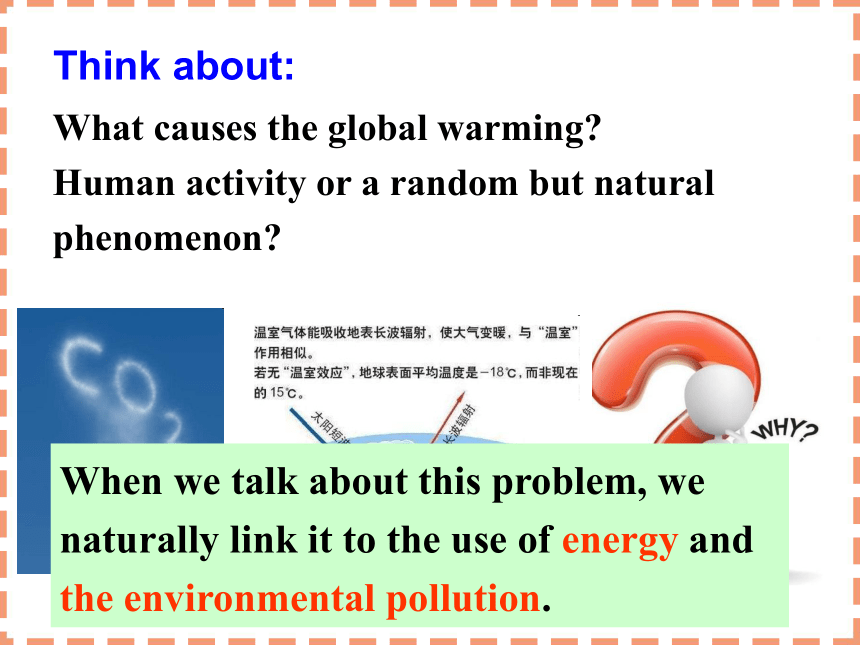
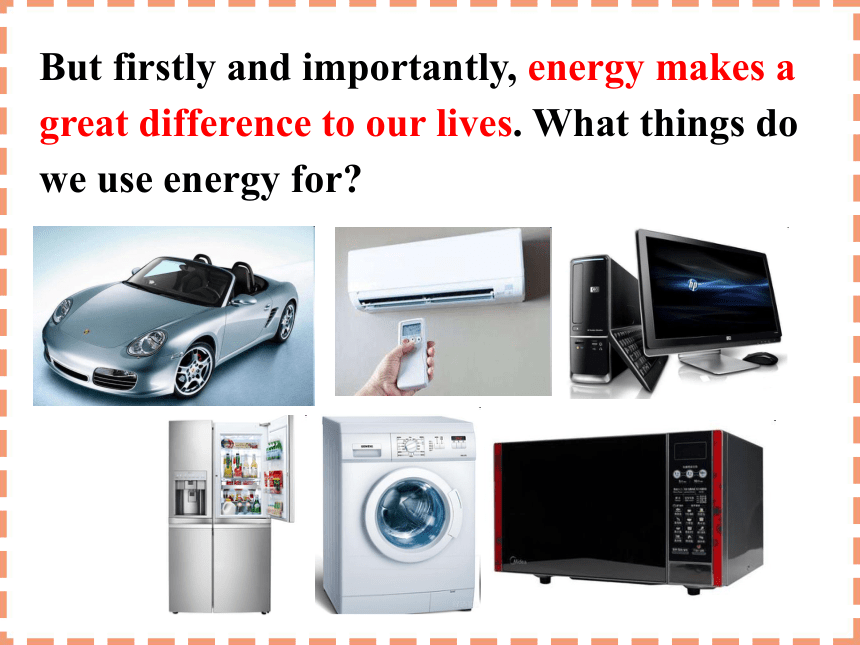

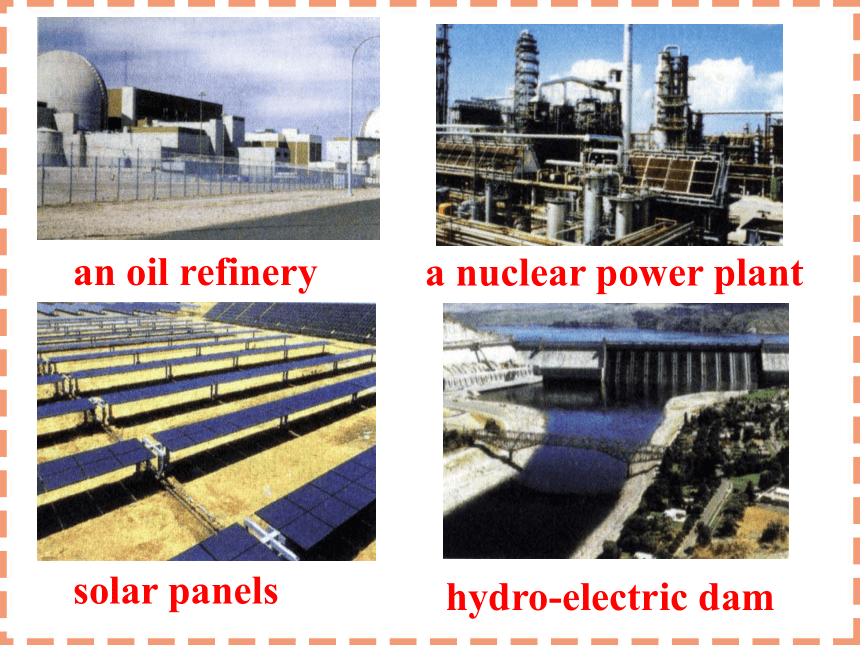

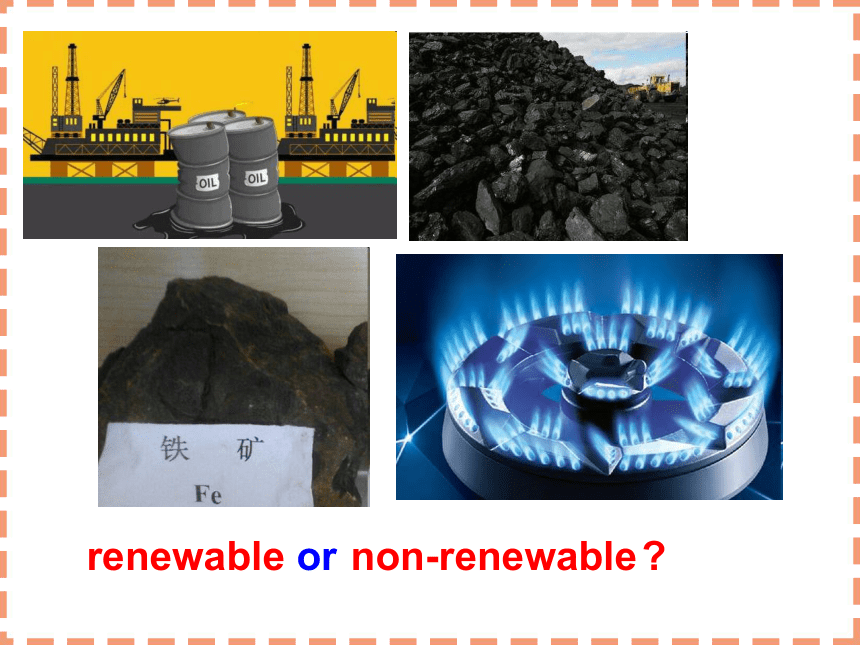

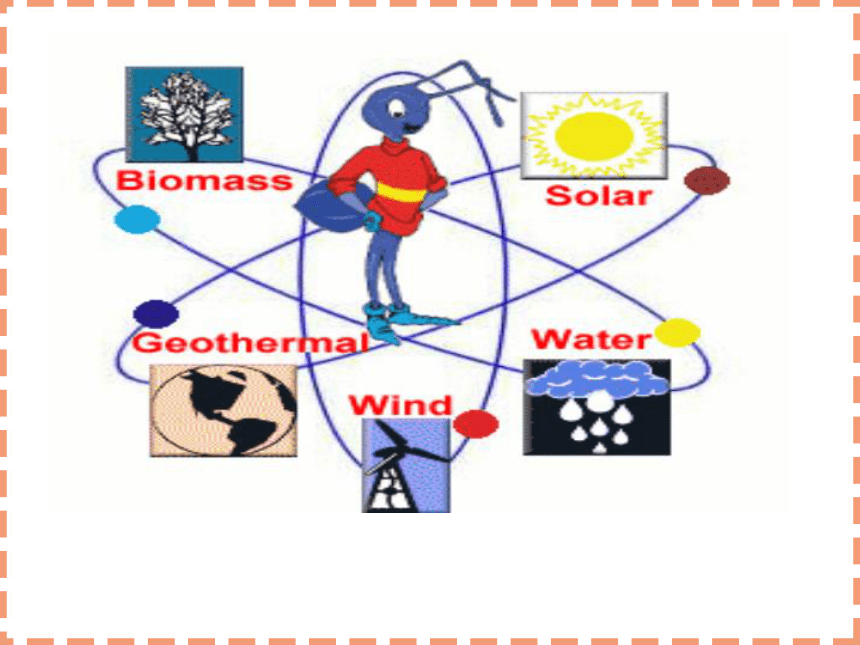
文档简介
1. To know more about the global warming.
2. To talk about whether or not we should do nothing to global warming.
What do you know about global warming?
What causes the global warming?
Human activity or a random but natural phenomenon?
Think about:
When we talk about this problem, we naturally link it to the use of energy and the environmental pollution.
But firstly and importantly, energy makes a great difference to our lives. What things do we use energy for?
We depend on energy to do many things in our daily life. Make a list of the things that consume energy. Where does all this energy come from?
windmills
a coal power station
an oil refinery
a nuclear power plant
solar panels
hydro-electric dam
An energy source is “renewable” when supplies of it never run out and “non-renewable” when one day they will run out. Which energy sources on your list are renewable and which are non-renewable?
non-renewable
renewable or ?
renewable
or non-renewable?
Carbon dioxide
coal
oil
natural gas
global warming
● ● ● ● ● ●
Why?
Fossil Fuels
Have you ever seen a greenhouse? What
is the greenhouse made and used for?
A greenhouse is made of glass and is used for growing plants, especially during cold weather.
How does it work?
The air inside is warm because the glass traps the heat from the sun and keeps it from escaping. This makes the greenhouse heat up and so the plants can grow throughout the cold period.
What are the “greenhouse gases”?
In the atmosphere surrounding the earth there are gases called “greenhouse gases”, including carbon dioxide, methane (甲烷, 沼气) and water vapor.
How do you understand “greenhouse
effects”?
They trap the heat from the sun, which
causes the temperature of earth goes up.
Main idea of each part
Writing techniques
(Paragraph 1)
Introduce a debate over the issue of global warming.
Raising a question
Main idea of each part
Writing techniques
(Paragraphs 2–5)
Illustrate how global warming comes about.
Giving examples, using graphs, explanation.
(Paragraphs 6)
List two different attitudes among scientists towards global warming.
Giving examples, making contrast.
Main idea of each part
Writing techniques
(Paragraph 7)
It’s up to readers to think and decide whether people should do something about global warming or not.
Using a question, leaving readers to think over the issue.
Main idea of each part
Writing techniques
Glance quickly at the magazine article and answer the questions.
1. Who wrote the magazine article?
What is the name of the magazine?
Sophie Armstrong wrote the magazine
article. The name of the magazine is
Earth Care.
2. What are the names of the three
scientists mentioned in the article?
They are Dr. Janice Foster,
Charles Keeling and George
Hambley.
3. What do they think about global
warming? Do they agree with one
another?
There are some very different attitudes
among scientists towards this issue.
Some think the effects will be terrible,
while some others believe that we
should not worry about it.
Graph I shows the temperature increase of one degree Fahrenheit between 1860 to 2000.
4. What are the two graphs about?
Graph 2 shows the carbon dioxide content in the atmosphere from 1957 to 1997.
5. What is the main topic of the article?
Global warming/ the warming of the
earth.
Read the text carefully and finish the following tasks.
fossil fuels?
go up
370
disasters
mild
climate
quicker
better
What do the three scientists think about the global warming?
Scientists
Opinion
Janice Foster
George Hambley
Charles Keeling
the effect of global warming could be very serious
global warming will be mild with few bad environmental consequences
It is the burning of more and more fossil fuels that is resulting in a big increase in carbon dioxide.
Join the correct parts of the sentences together.
1. Sophie Armstrong
2. Carbon dioxide?
3. The greenhouse effect
4. Charles Keeling?
5. Janice Foster
?
6. George Hambley
A. helps to keep the earth warm enough for people to live in.
B. researched the reason and effect of the rapid change of the earth’s temperature.
C. is the most important of “greenhouse” gases.
D. thought that global warming would be a good thing for human beings.
E. predicted how warmer the earth would become in the next 100 years.
F. recorded the amount of carbon dioxide in the air from 1957 to 1997.
1. The temperature in the last century
did not seem to increase much.
2. Everyone believes that global warming
is caused by the activities of humans.
3. Janice Foster believes that she can
measure the future global rise in
temperature.
4. The rise in carbon dioxide is causing a
steady increase in global warming.
5. George Hambley believes that global
warming will do good rather than
harm to the earth.
6. It is clear what the effects of global
warming will be.
Decide which are opinions (O) and
which are facts (F).
( ) 1. Coal, natural gas and oil are fossil fuels.
( ) 2. The “greenhouse effect” is a natural phenomenon.
( ) 3. The “greenhouse effect” makes our life worse.
( ) 4. The amount of carbon dioxide increased from about 315 parts to about 370 parts per million from 1957 to 1997.
F
F
O
F
( ) 5. Global warming will have a serious effect on human beings.
( ) 6. It is not necessary to worry too much about the high level of carbon dioxide.
( ) 7. More carbon dioxide will help produce more crops.
( ) 8. The earth’s climate will continue to become warmer.
O
O
O
O
Describe the process of the rising of the earth's temperature because of the “greenhouse effect”.
Global warming
1. The planet has warmed anywhere from 0.5 to 1.0℃ (1 to 2℉) over the last century.
2. A definition of global warming would have to include a measurable, consistent temperature rise, like the one we have seen in recent history. A question remains – Is it an unusual change? Much debate about that one.
3. The earth gets one kind of energy (visible light) from the sun and gives off another kind (infrared红外线). This kind is what gets trapped by “greenhouse gases” (GHG’s) in the atmosphere.
Green house gases
4. The global warming green house effect really is a bogus (假的) term. A greenhouse keeps warm by physically trapping the air inside and preventing convection (对流). The atmosphere helps keep the planet warm by trapping outgoing radiation instead.
5. The leading gasses are Carbon-dioxide, Methane, Ozone (臭氧) and Nitrous Oxide (一氧化二氮). Gas analyzers show the concentrations of this stuff have increased somewhat since the beginning of the industrial revolution.
6. The greenhouse effect raises the
average temperature of the Earth by
more than 30 degrees, so without it the
Earth would be a very cold place!
green house effect
Write a passage about global warming.
2. To talk about whether or not we should do nothing to global warming.
What do you know about global warming?
What causes the global warming?
Human activity or a random but natural phenomenon?
Think about:
When we talk about this problem, we naturally link it to the use of energy and the environmental pollution.
But firstly and importantly, energy makes a great difference to our lives. What things do we use energy for?
We depend on energy to do many things in our daily life. Make a list of the things that consume energy. Where does all this energy come from?
windmills
a coal power station
an oil refinery
a nuclear power plant
solar panels
hydro-electric dam
An energy source is “renewable” when supplies of it never run out and “non-renewable” when one day they will run out. Which energy sources on your list are renewable and which are non-renewable?
non-renewable
renewable or ?
renewable
or non-renewable?
Carbon dioxide
coal
oil
natural gas
global warming
● ● ● ● ● ●
Why?
Fossil Fuels
Have you ever seen a greenhouse? What
is the greenhouse made and used for?
A greenhouse is made of glass and is used for growing plants, especially during cold weather.
How does it work?
The air inside is warm because the glass traps the heat from the sun and keeps it from escaping. This makes the greenhouse heat up and so the plants can grow throughout the cold period.
What are the “greenhouse gases”?
In the atmosphere surrounding the earth there are gases called “greenhouse gases”, including carbon dioxide, methane (甲烷, 沼气) and water vapor.
How do you understand “greenhouse
effects”?
They trap the heat from the sun, which
causes the temperature of earth goes up.
Main idea of each part
Writing techniques
(Paragraph 1)
Introduce a debate over the issue of global warming.
Raising a question
Main idea of each part
Writing techniques
(Paragraphs 2–5)
Illustrate how global warming comes about.
Giving examples, using graphs, explanation.
(Paragraphs 6)
List two different attitudes among scientists towards global warming.
Giving examples, making contrast.
Main idea of each part
Writing techniques
(Paragraph 7)
It’s up to readers to think and decide whether people should do something about global warming or not.
Using a question, leaving readers to think over the issue.
Main idea of each part
Writing techniques
Glance quickly at the magazine article and answer the questions.
1. Who wrote the magazine article?
What is the name of the magazine?
Sophie Armstrong wrote the magazine
article. The name of the magazine is
Earth Care.
2. What are the names of the three
scientists mentioned in the article?
They are Dr. Janice Foster,
Charles Keeling and George
Hambley.
3. What do they think about global
warming? Do they agree with one
another?
There are some very different attitudes
among scientists towards this issue.
Some think the effects will be terrible,
while some others believe that we
should not worry about it.
Graph I shows the temperature increase of one degree Fahrenheit between 1860 to 2000.
4. What are the two graphs about?
Graph 2 shows the carbon dioxide content in the atmosphere from 1957 to 1997.
5. What is the main topic of the article?
Global warming/ the warming of the
earth.
Read the text carefully and finish the following tasks.
fossil fuels?
go up
370
disasters
mild
climate
quicker
better
What do the three scientists think about the global warming?
Scientists
Opinion
Janice Foster
George Hambley
Charles Keeling
the effect of global warming could be very serious
global warming will be mild with few bad environmental consequences
It is the burning of more and more fossil fuels that is resulting in a big increase in carbon dioxide.
Join the correct parts of the sentences together.
1. Sophie Armstrong
2. Carbon dioxide?
3. The greenhouse effect
4. Charles Keeling?
5. Janice Foster
?
6. George Hambley
A. helps to keep the earth warm enough for people to live in.
B. researched the reason and effect of the rapid change of the earth’s temperature.
C. is the most important of “greenhouse” gases.
D. thought that global warming would be a good thing for human beings.
E. predicted how warmer the earth would become in the next 100 years.
F. recorded the amount of carbon dioxide in the air from 1957 to 1997.
1. The temperature in the last century
did not seem to increase much.
2. Everyone believes that global warming
is caused by the activities of humans.
3. Janice Foster believes that she can
measure the future global rise in
temperature.
4. The rise in carbon dioxide is causing a
steady increase in global warming.
5. George Hambley believes that global
warming will do good rather than
harm to the earth.
6. It is clear what the effects of global
warming will be.
Decide which are opinions (O) and
which are facts (F).
( ) 1. Coal, natural gas and oil are fossil fuels.
( ) 2. The “greenhouse effect” is a natural phenomenon.
( ) 3. The “greenhouse effect” makes our life worse.
( ) 4. The amount of carbon dioxide increased from about 315 parts to about 370 parts per million from 1957 to 1997.
F
F
O
F
( ) 5. Global warming will have a serious effect on human beings.
( ) 6. It is not necessary to worry too much about the high level of carbon dioxide.
( ) 7. More carbon dioxide will help produce more crops.
( ) 8. The earth’s climate will continue to become warmer.
O
O
O
O
Describe the process of the rising of the earth's temperature because of the “greenhouse effect”.
Global warming
1. The planet has warmed anywhere from 0.5 to 1.0℃ (1 to 2℉) over the last century.
2. A definition of global warming would have to include a measurable, consistent temperature rise, like the one we have seen in recent history. A question remains – Is it an unusual change? Much debate about that one.
3. The earth gets one kind of energy (visible light) from the sun and gives off another kind (infrared红外线). This kind is what gets trapped by “greenhouse gases” (GHG’s) in the atmosphere.
Green house gases
4. The global warming green house effect really is a bogus (假的) term. A greenhouse keeps warm by physically trapping the air inside and preventing convection (对流). The atmosphere helps keep the planet warm by trapping outgoing radiation instead.
5. The leading gasses are Carbon-dioxide, Methane, Ozone (臭氧) and Nitrous Oxide (一氧化二氮). Gas analyzers show the concentrations of this stuff have increased somewhat since the beginning of the industrial revolution.
6. The greenhouse effect raises the
average temperature of the Earth by
more than 30 degrees, so without it the
Earth would be a very cold place!
green house effect
Write a passage about global warming.
